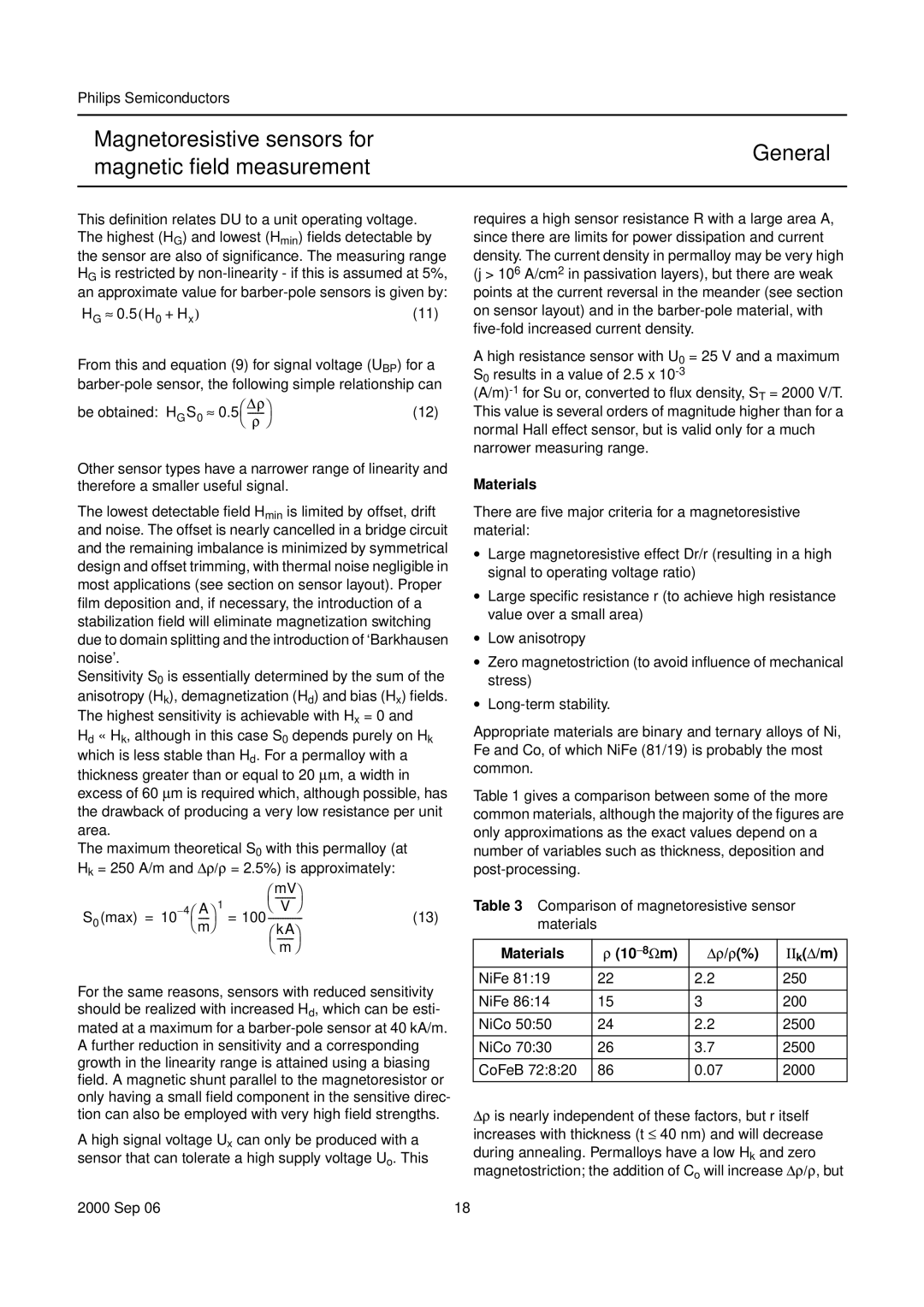
Philips Semiconductors
Magnetoresistive sensors for |
| General | ||||||||
magnetic field measurement |
| |||||||||
|
| |||||||||
|
| |||||||||
This definition relates DU to a unit operating voltage. | requires a high sensor resistance R with a large area A, | |||||||||
The highest (HG) and lowest (Hmin) fields detectable by | since there are limits for power dissipation and current | |||||||||
the sensor are also of significance. The measuring range | density. The current density in permalloy may be very high | |||||||||
HG is restricted by | (j > 106 A/cm2 in passivation layers), but there are weak | |||||||||
an approximate value for | points at the current reversal in the meander (see section | |||||||||
HG ≈ 0.5(H0 + Hx) |
|
|
|
| (11) | on sensor layout) and in the | ||||
|
|
|
|
|
|
|
|
| ||
From this and equation (9) for signal voltage (UBP) for a | A high resistance sensor with U0 = 25 V and a maximum | |||||||||
S results in a value of 2.5 x | ||||||||||
0 | ||||||||||
|
|
|
|
|
|
|
|
| ||
|
|
|
| ≈ 0.5 | ⎛ | Δρ⎞ |
| T | ||
be obtained: H |
| S |
| (12) | This value is several orders of magnitude higher than for a | |||||
G | 0 | ⎝ | ⎠ | |||||||
|
|
| ρ |
| normal Hall effect sensor, but is valid only for a much | |||||
|
|
|
|
|
|
|
|
| ||
narrower measuring range.
Other sensor types have a narrower range of linearity and therefore a smaller useful signal.
The lowest detectable field Hmin is limited by offset, drift and noise. The offset is nearly cancelled in a bridge circuit and the remaining imbalance is minimized by symmetrical design and offset trimming, with thermal noise negligible in most applications (see section on sensor layout). Proper film deposition and, if necessary, the introduction of a stabilization field will eliminate magnetization switching due to domain splitting and the introduction of ‘Barkhausen noise’.
Sensitivity S0 is essentially determined by the sum of the anisotropy (Hk), demagnetization (Hd) and bias (Hx) fields. The highest sensitivity is achievable with Hx = 0 and
Hd « Hk, although in this case S0 depends purely on Hk which is less stable than Hd. For a permalloy with a thickness greater than or equal to 20 μm, a width in excess of 60 μm is required which, although possible, has the drawback of producing a very low resistance per unit area.
The maximum theoretical S0 with this permalloy (at Hk = 250 A/m and Δρ/ρ = 2.5%) is approximately:
|
|
|
|
| ⎛ A | ⎞ 1 | ⎛ |
| |
S |
| (max) | = 10 | ⎝ | V ⎠ | (13) | |||
|
|
| = | ||||||
| 0 |
|
|
| ⎝ m⎠ | ⎛ |
| ||
|
|
|
|
|
|
| ⎝ | m ⎠ |
|
For the same reasons, sensors with reduced sensitivity should be realized with increased Hd, which can be esti- mated at a maximum for a
A high signal voltage Ux can only be produced with a sensor that can tolerate a high supply voltage Uo. This
Materials
There are five major criteria for a magnetoresistive material:
∙Large magnetoresistive effect Dr/r (resulting in a high signal to operating voltage ratio)
∙Large specific resistance r (to achieve high resistance value over a small area)
∙Low anisotropy
∙Zero magnetostriction (to avoid influence of mechanical stress)
∙
Appropriate materials are binary and ternary alloys of Ni, Fe and Co, of which NiFe (81/19) is probably the most common.
Table 1 gives a comparison between some of the more common materials, although the majority of the figures are only approximations as the exact values depend on a number of variables such as thickness, deposition and
Table 3 Comparison of magnetoresistive sensor materials
Materials | ρ (10−8Ωm) | Δρ/ρ(%) | ΙΙk(Δ/m) |
NiFe 81:19 | 22 | 2.2 | 250 |
|
|
|
|
NiFe 86:14 | 15 | 3 | 200 |
|
|
|
|
NiCo 50:50 | 24 | 2.2 | 2500 |
|
|
|
|
NiCo 70:30 | 26 | 3.7 | 2500 |
|
|
|
|
CoFeB 72:8:20 | 86 | 0.07 | 2000 |
|
|
|
|
Δρ is nearly independent of these factors, but r itself increases with thickness (t ≤ 40 nm) and will decrease during annealing. Permalloys have a low Hk and zero magnetostriction; the addition of Co will increase Δρ/ρ, but
2000 Sep 06 | 18 |
